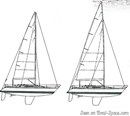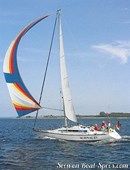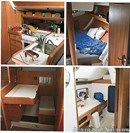X-372 Fractional rigging
Sailboat specifications
The X-372 is a 36’4” (11.05m) cruiser-racer sailboat designed by Niels Jeppesen (Denmark). She was built between 1987 and 1992 by X-Yachts (Denmark) with 120 hulls completed. The Fractional rigging version features 7/8 rig and running backstays allowing finer sail trimming options and lower IOR rating.
The X-372 is as well listed, on Boat-Specs.com, in Mast head rigging version (see all the versions compared).
The X-372 is as well listed, on Boat-Specs.com, in Mast head rigging version (see all the versions compared).
X-372's main features
- Model
- X-372
- Version
- Fractional rigging
- Hull type
- Monohull
- Category
- Cruiser-racer sailboat
- Sailboat builder
- Sailboat designer
- Country
- Denmark
- Construction
- GRP (glass reinforced polyester):
Sandwich fiberglass polyester with galvanized steel frame - Number of hulls built
- 120
- First built hull
- 1987
- Last built hull
- 1992
- Appendages
- Keel : fin without bulb
- Helm
- Single tiller (helm wheel in option)
- Rudder
- Single spade rudder
- Unsinkable
- No
- Trailerable
- No
- Standard public price ex. VAT (indicative only)
- N/A €
X-372's main dimensions
- Overall length
- 37’ 8”11.48 m
- Hull length
- 36’ 4”11.05 m
- Waterline length
- 29’ 6”9 m
- Beam (width)
- 11’ 8”3.57 m
- Draft
- 6’ 7”2 m
- Light displacement (MLC)
- 11244 lb5100 kg
- Ballast weight
- 4850 lb2200 kg
- Ballast type
- Cast iron / lead fin
X-372's rig and sails
- Upwind sail area
- 885 ft²82.2 m²
- Downwind sail area
- 1396 ft²129.7 m²
- Mainsail area
- 445 ft²41.3 m²
- Genoa area
- 440 ft²40.9 m²
- Solent area
- 294 ft²27.3 m²
- Stormjib area
- 94 ft²8.7 m²
- Symmetric spinnaker area
- 952 ft²88.4 m²
- Rigging type
- Sloop Marconi masthead
- Mast configuration
- Keel stepped mast
- Rotating spars
- No
- Number of levels of spreaders
- 2
- Spreaders angle
- 0 °
- Running backstays
- 2 set(s)
- Spars construction
- Aluminum spars
X-372's performances
- Upwind sail area to displacementiThe ratio sail area to displacement is obtained by dividing the sail area by the boat's displaced volume to the power two-thirds.
The ratio sail area to displacement can be used to compare the relative sail plan of different sailboats no matter what their size.
Upwind: under 18 the ratio indicates a cruise oriented sailboat with limited performances especially in light wind, while over 25 it indicates a fast sailboat. - 299 ft²/T27.74 m²/T
- Downwind sail area to displacementiThe ratio sail area to displacement is obtained by dividing the sail area by the boat's displaced volume to the power two-thirds.
The ratio sail area to displacement can be used to compare the relative sail plan of different sailboats no matter what their size. - 471 ft²/T43.78 m²/T
- Displacement-length ratio (DLR)iThe Displacement Length Ratio (DLR) is a figure that points out the boat's weight compared to its waterline length. The DLR is obtained by dividing the boat's displacement in tons by the cube of one one-hundredth of the waterline length (in feet).
The DLR can be used to compare the relative mass of different sailboats no matter what their length:
a DLR less than 180 is indicative of a really light sailboat (race boat made for planning), while a DLR greater than 300 is indicative of a heavy cruising sailboat. - 198
- Ballast ratioiThe Ballast ratio is an indicator of stability; it is obtained by dividing the boat's displacement by the mass of the ballast. Since the stability depends also of the hull shapes and the position of the center of gravity, only the boats with similar ballast arrangements and hull shapes should be compared.
The higher the ballast ratio is, the greater is the stability. - 43 %
- Critical hull speediAs a ship moves in the water, it creates standing waves that oppose its movement. This effect increases dramatically the resistance when the boat reaches a speed-length ratio (speed-length ratio is the ratio between the speed in knots and the square root of the waterline length in feet) of about 1.2 (corresponding to a Froude Number of 0.35) . This very sharp rise in resistance, between speed-length ratio of 1.2 to 1.5, is insurmountable for heavy sailboats and so becomes an apparent barrier. This leads to the concept of "hull speed".
The hull speed is obtained by multiplying the square root of the waterline length (in feet) by 1.34. - 7.28 knots
X-372's auxiliary engine
- Engine(s)
- 1 inboard engine
- Engine(s) power
- 28 HP
- Fuel type
- Diesel
X-372's accommodations and layout
- Cockpit
- Open aft cockpit
- Cabin(s)
- 2
- Berth(s) (min./max.)
- 4 / 6
- Head(s)
- 1
- Maximum headroom
- 6’ 2”1.9 m







X-Yachts X-372 interior and accommodations - - 6/7
Picture extracted from the commercial documentation © X-Yachts
Picture extracted from the commercial documentation © X-Yachts


X-Yachts X-372 interior and accommodations - - 7/7
Picture extracted from the commercial documentation © X-Yachts
Picture extracted from the commercial documentation © X-Yachts
Similar sailboats that may interest you:
Sailboats
First built hull
Hull length
1992
37’ 5”11.4 m
1988
33’ 6”10.22 m
1987
36’ 4”11.05 m
2017
40’12.2 m
1983
34’ 10”10.6 m
1992
34’ 7”10.55 m
1989
30’ 4”9.25 m
1988
34’ 10”10.6 m
2002
35’10.68 m
1983
34’ 7”10.55 m
1979
34’ 10”10.6 m
1998
35’ 2”10.73 m
1985
37’11.27 m
2005
37’ 1”11.3 m
2004
37’ 2”11.35 m